Unit 4 Natural Disasters reading and thinking (教学课件)-2024-2025学年 新人教版高中英语必修一
文档属性
| 名称 | Unit 4 Natural Disasters reading and thinking (教学课件)-2024-2025学年 新人教版高中英语必修一 | 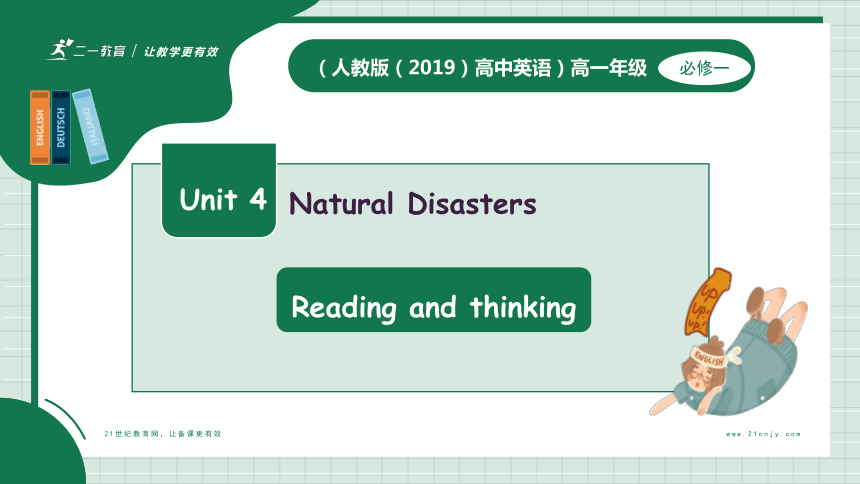 | |
| 格式 | pptx | ||
| 文件大小 | 75.5MB | ||
| 资源类型 | 试卷 | ||
| 版本资源 | 人教版(2019) | ||
| 科目 | 英语 | ||
| 更新时间 | 2025-03-29 12:09:09 | ||
图片预览

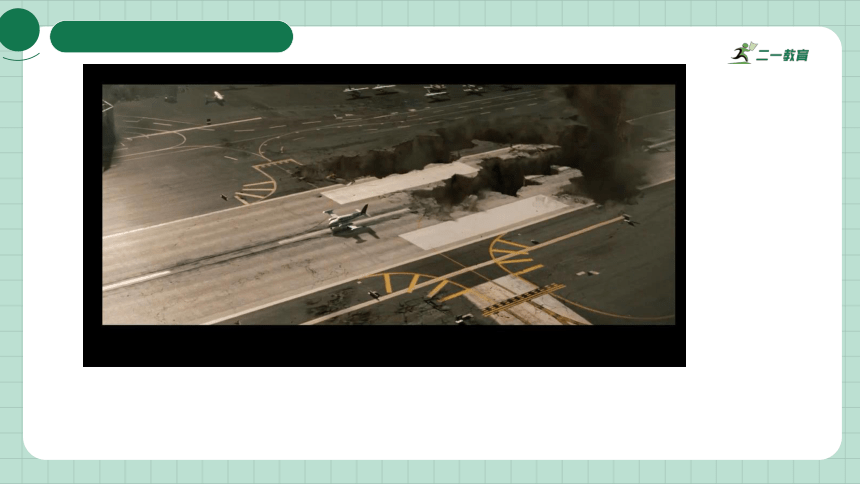
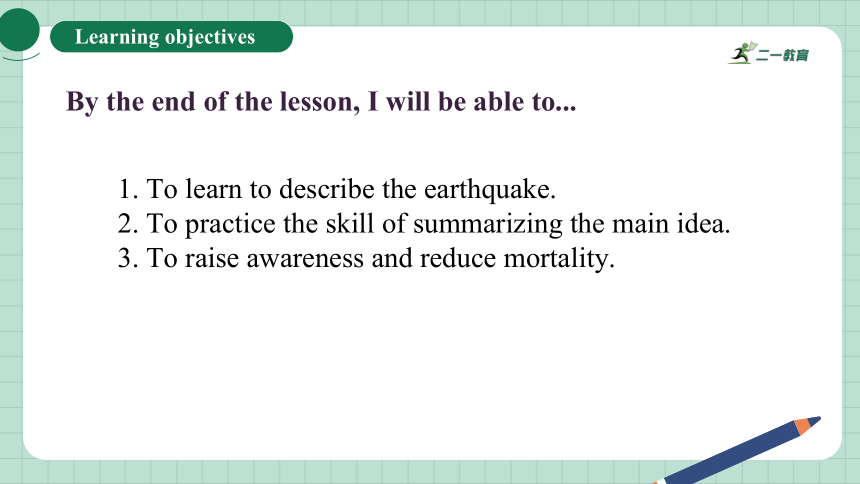
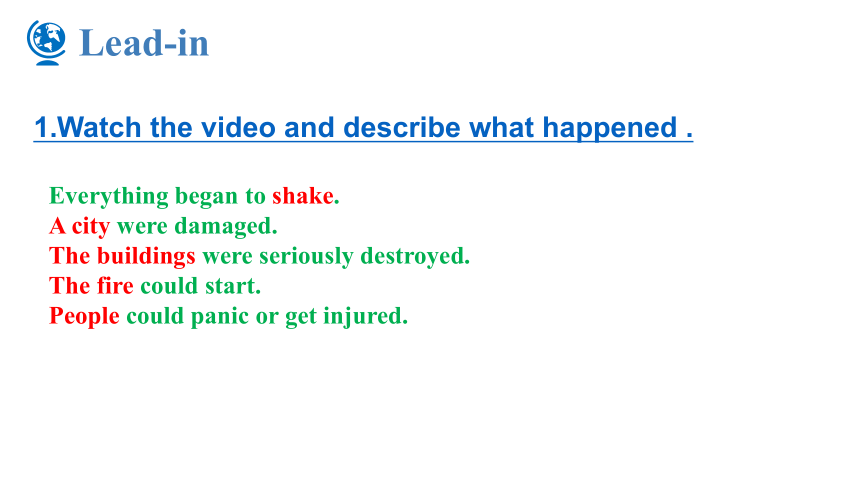
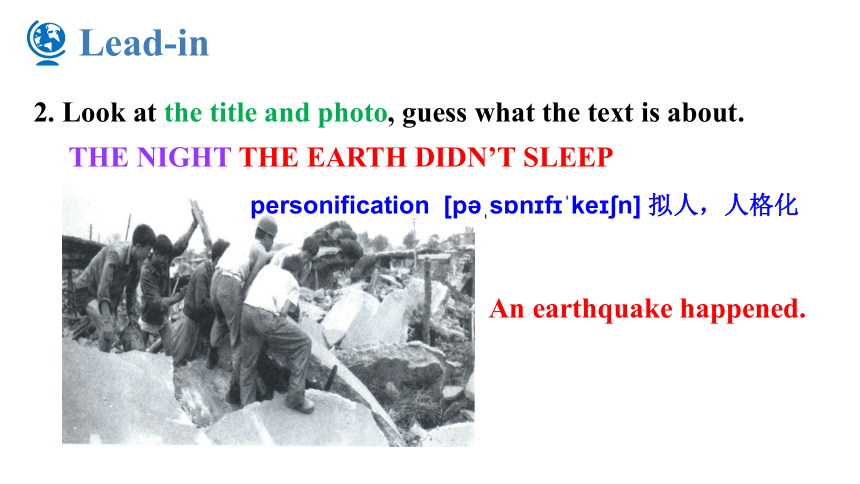
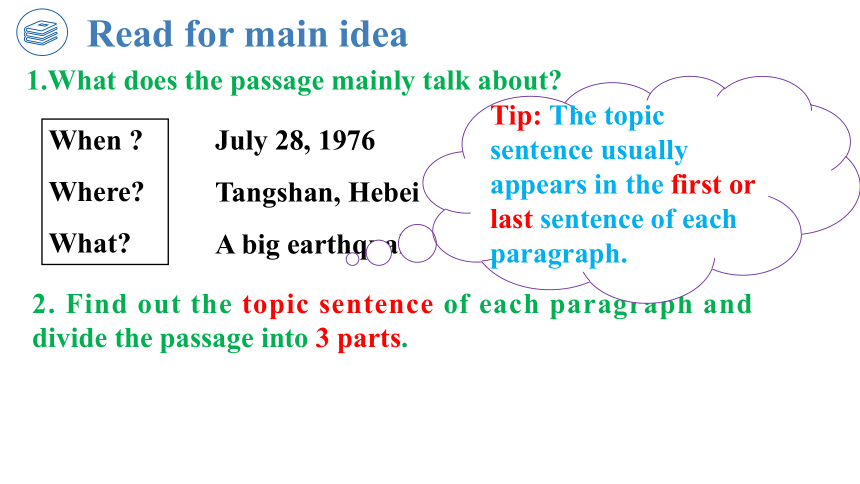
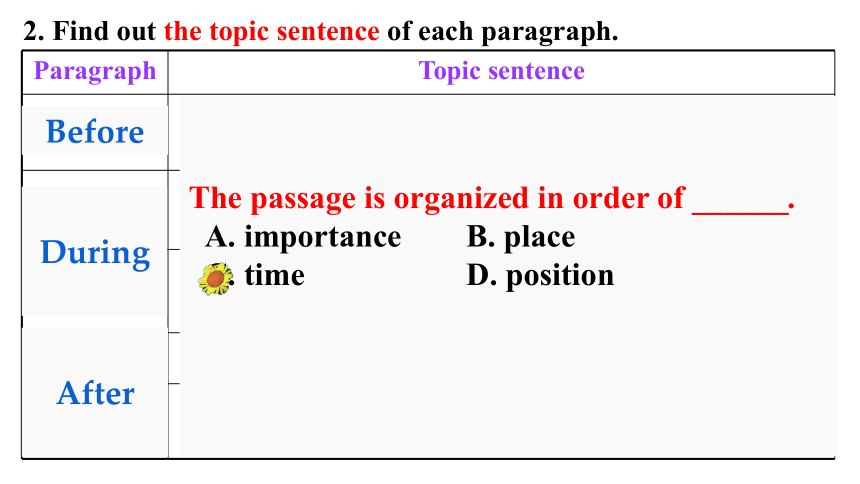
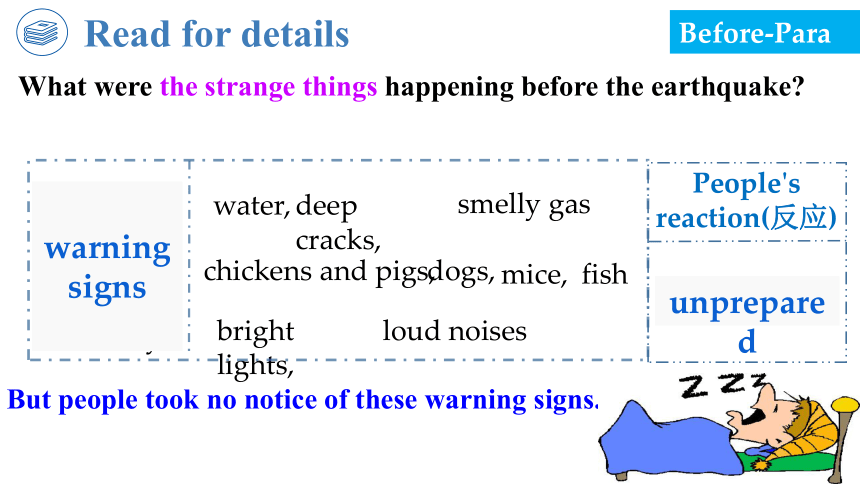
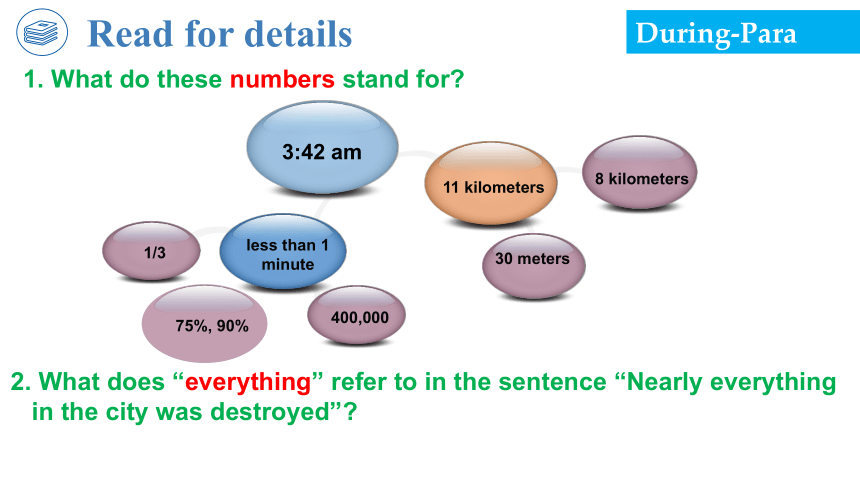
文档简介
(共26张PPT)
(人教版(2019)高中英语)高一年级
必修一
Reading and thinking
Natural Disasters
Unit 4
Learning objectives
By the end of the lesson, I will be able to...
1. To learn to describe the earthquake.
2. To practice the skill of summarizing the main idea.
3. To raise awareness and reduce mortality.
Lead-in
1.Watch the video and describe what happened .
Everything began to shake.
A city were damaged.
The buildings were seriously destroyed.
The fire could start.
People could panic or get injured.
Lead-in
2. Look at the title and photo, guess what the text is about.
THE NIGHT THE EARTH DIDN’T SLEEP
An earthquake happened.
personification [p s n f ke n] 拟人,人格化
1.What does the passage mainly talk about
When
Where
What
July 28, 1976
Tangshan, Hebei
A big earthquake
A big earthquake happened in Tangshan on July 28, 1976.
2. Find out the topic sentence of each paragraph and divide the passage into 3 parts.
fast reading
Read for main idea
Tip: The topic sentence usually appears in the first or last sentence of each paragraph.
2. Find out the topic sentence of each paragraph.
Paragraph Topic sentence
1
2
3
4
5
Strange things were happening in the countryside of northeastern Hebei.
Everything began to shake. It seemed as if the world were coming to end.
Everywhere survivors looked, there was nothing but ruins. Nearly everything in the city was destroyed.
But hope was not lost.
Tangshan started to revive itself and get back up on its feet.
Before
During
After
The passage is organized in order of ______.
A. importance B. place
C. time D. position
In the well
Animals
In the sky
water,
deep cracks,
smelly gas
chickens and pigs,
dogs,
mice,
fish
bright lights,
loud noises
Before-Para 1
People's reaction(反应)
unprepared
warning signs
What were the strange things happening before the earthquake
Read for details
But people took no notice of these warning signs.
1. What do these numbers stand for
Read for details
During-Para 2&3
less than 1 minute
11 kilometers
8 kilometers
30 meters
1/3
400,000
3:42 am
75%, 90%
2. What does “everything” refer to in the sentence “Nearly everything
in the city was destroyed”
3:42 am
11 kilometers
8 kilometers
30 meters
At 3:42 am everything began to shake.
11 kilometers directly below the city
A huge crack was 8 kilometers long.
A huge crack was 30 meters wide.
Read for details
During-Para 2&3
What do these numbers stand for
less than 1 minute
1/3
75%, 90%
400,000
In less than 1 minute, a large city lay in ruins.
The number of people who were killed or badly injured in the quake was more than 400,000.
One-third of the nation felt the earthquake.
75% of the city’s factories and buildings and 90% of its homes were gone.
Read for details
During-Para 2&3
one of the most deadly earthquakes of the 20th century
reading skill:
use context to understand new words or phrases
It is used to describe a place that has been badly damaged.
During-Para 2&3
Read for details
2. What does “everything” refer to in the sentence “Nearly everything
in the city was destroyed”
railway tracks
cows
pigs
chickens
wells
hospitals
factories
bricks
homes
bridges
everything
buildings
hopeless
After-Para 4&5
Read for details
1.Who came to rescue What did they do
2.What does the author mean by “Slowly, the city began to
breathe again”
3. How was a new Tangshan built upon the earthquake ruins
What is Tangshan now
4.What should we do in times of disasters
Who
After-Para 4&5
the army/the soldiers
dig out those who were trapped and bury the dead
the doctors and nurses
provide medical care
workers
build shelters
water and food was brought
What
Read for details
Who came to rescue What did they do
This verb is used to describe people who are not dead, but they need help to be dug out, so it must mean they can’t move because they are stuck somewhere.
reading skill:
use context to understand new words or phrases
Workers built shelters for survivors whose homes had been destroyed.
attributive clause 定语从句
工人们为那些家园被毁的幸存者盖起了避难所。
从句
主句
After-Para 4&5
Read for details
After-Para 4&5
Read for details
2.What does the author mean by “Slowly, the city began to
breathe again”
The writer means that the city began to function again, because the earthquake had stopped people and supplies moving about, and so it was like the city couldn’t breathe.
Personification [p s n f ke n] 拟人,人格化
3. How was a new Tangshan built upon the earthquake ruins What is Tangshan now
A new Tangshan
a home to ....
great improvements..
Earthquake ruins
tireless efforts
strong support
Read for details
After-Para 4&5
Tangshan’s new look
God help those who help themselves!
hopeful
confident
Discussion & Roleplay
What lessons can we learn from Tangshan earthquake
1) People thought no notice of the warning signs.
Ignorance might be deadly.
2) Life is weak, but if people work together to help each other, disasters can be defeated.
There is no love in disaster, but we have love in human heart.
What should we do in times of earthquake
Where there is a disaster,
there is the People’s Republic of China.
Discussion & Roleplay
Summary
summary
3.place
2.time
1.date
7. revival
Tip:
A summary is a short paragraph of main points which keeps the important information.
paraphrase释义
4.event
6. rescue
effects
What happened to the city and the people
Who came and what did they do
How was Tangshan rebuilt
At 3:42 a.m. on July 28, 1976, one of the most terrible earthquakes hit Tangshan. The people there who took no notice of the warning signs were asleep as usual. Therefore, the city was greatly damaged and many people were killed or injured. Luckily, the rescue workers came to help the survivors soon after the quakes. With the government’s support and people’s efforts, a new Tangshan was built.
Summary
Homework
Write a summary for the text about 60 words. Use some
attributive clauses(定语从句) if possible.
25
(人教版(2019)高中英语)高一年级
必修一
Reading and thinking
Natural Disasters
Unit 4
Learning objectives
By the end of the lesson, I will be able to...
1. To learn to describe the earthquake.
2. To practice the skill of summarizing the main idea.
3. To raise awareness and reduce mortality.
Lead-in
1.Watch the video and describe what happened .
Everything began to shake.
A city were damaged.
The buildings were seriously destroyed.
The fire could start.
People could panic or get injured.
Lead-in
2. Look at the title and photo, guess what the text is about.
THE NIGHT THE EARTH DIDN’T SLEEP
An earthquake happened.
personification [p s n f ke n] 拟人,人格化
1.What does the passage mainly talk about
When
Where
What
July 28, 1976
Tangshan, Hebei
A big earthquake
A big earthquake happened in Tangshan on July 28, 1976.
2. Find out the topic sentence of each paragraph and divide the passage into 3 parts.
fast reading
Read for main idea
Tip: The topic sentence usually appears in the first or last sentence of each paragraph.
2. Find out the topic sentence of each paragraph.
Paragraph Topic sentence
1
2
3
4
5
Strange things were happening in the countryside of northeastern Hebei.
Everything began to shake. It seemed as if the world were coming to end.
Everywhere survivors looked, there was nothing but ruins. Nearly everything in the city was destroyed.
But hope was not lost.
Tangshan started to revive itself and get back up on its feet.
Before
During
After
The passage is organized in order of ______.
A. importance B. place
C. time D. position
In the well
Animals
In the sky
water,
deep cracks,
smelly gas
chickens and pigs,
dogs,
mice,
fish
bright lights,
loud noises
Before-Para 1
People's reaction(反应)
unprepared
warning signs
What were the strange things happening before the earthquake
Read for details
But people took no notice of these warning signs.
1. What do these numbers stand for
Read for details
During-Para 2&3
less than 1 minute
11 kilometers
8 kilometers
30 meters
1/3
400,000
3:42 am
75%, 90%
2. What does “everything” refer to in the sentence “Nearly everything
in the city was destroyed”
3:42 am
11 kilometers
8 kilometers
30 meters
At 3:42 am everything began to shake.
11 kilometers directly below the city
A huge crack was 8 kilometers long.
A huge crack was 30 meters wide.
Read for details
During-Para 2&3
What do these numbers stand for
less than 1 minute
1/3
75%, 90%
400,000
In less than 1 minute, a large city lay in ruins.
The number of people who were killed or badly injured in the quake was more than 400,000.
One-third of the nation felt the earthquake.
75% of the city’s factories and buildings and 90% of its homes were gone.
Read for details
During-Para 2&3
one of the most deadly earthquakes of the 20th century
reading skill:
use context to understand new words or phrases
It is used to describe a place that has been badly damaged.
During-Para 2&3
Read for details
2. What does “everything” refer to in the sentence “Nearly everything
in the city was destroyed”
railway tracks
cows
pigs
chickens
wells
hospitals
factories
bricks
homes
bridges
everything
buildings
hopeless
After-Para 4&5
Read for details
1.Who came to rescue What did they do
2.What does the author mean by “Slowly, the city began to
breathe again”
3. How was a new Tangshan built upon the earthquake ruins
What is Tangshan now
4.What should we do in times of disasters
Who
After-Para 4&5
the army/the soldiers
dig out those who were trapped and bury the dead
the doctors and nurses
provide medical care
workers
build shelters
water and food was brought
What
Read for details
Who came to rescue What did they do
This verb is used to describe people who are not dead, but they need help to be dug out, so it must mean they can’t move because they are stuck somewhere.
reading skill:
use context to understand new words or phrases
Workers built shelters for survivors whose homes had been destroyed.
attributive clause 定语从句
工人们为那些家园被毁的幸存者盖起了避难所。
从句
主句
After-Para 4&5
Read for details
After-Para 4&5
Read for details
2.What does the author mean by “Slowly, the city began to
breathe again”
The writer means that the city began to function again, because the earthquake had stopped people and supplies moving about, and so it was like the city couldn’t breathe.
Personification [p s n f ke n] 拟人,人格化
3. How was a new Tangshan built upon the earthquake ruins What is Tangshan now
A new Tangshan
a home to ....
great improvements..
Earthquake ruins
tireless efforts
strong support
Read for details
After-Para 4&5
Tangshan’s new look
God help those who help themselves!
hopeful
confident
Discussion & Roleplay
What lessons can we learn from Tangshan earthquake
1) People thought no notice of the warning signs.
Ignorance might be deadly.
2) Life is weak, but if people work together to help each other, disasters can be defeated.
There is no love in disaster, but we have love in human heart.
What should we do in times of earthquake
Where there is a disaster,
there is the People’s Republic of China.
Discussion & Roleplay
Summary
summary
3.place
2.time
1.date
7. revival
Tip:
A summary is a short paragraph of main points which keeps the important information.
paraphrase释义
4.event
6. rescue
effects
What happened to the city and the people
Who came and what did they do
How was Tangshan rebuilt
At 3:42 a.m. on July 28, 1976, one of the most terrible earthquakes hit Tangshan. The people there who took no notice of the warning signs were asleep as usual. Therefore, the city was greatly damaged and many people were killed or injured. Luckily, the rescue workers came to help the survivors soon after the quakes. With the government’s support and people’s efforts, a new Tangshan was built.
Summary
Homework
Write a summary for the text about 60 words. Use some
attributive clauses(定语从句) if possible.
25
